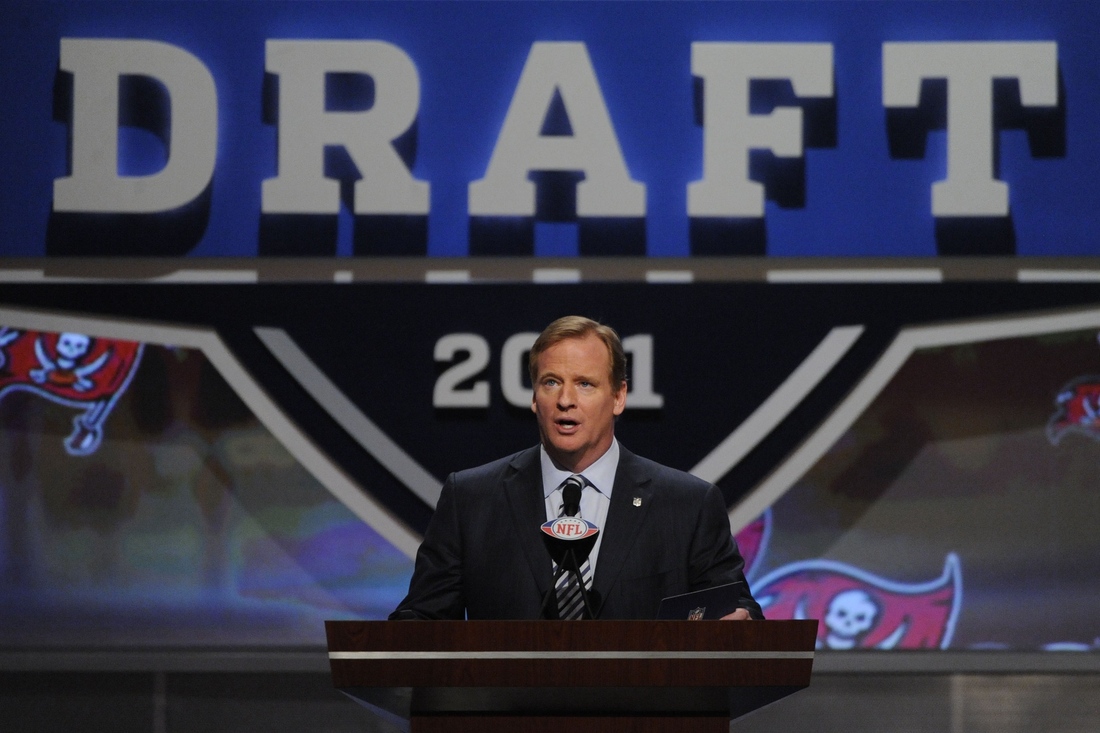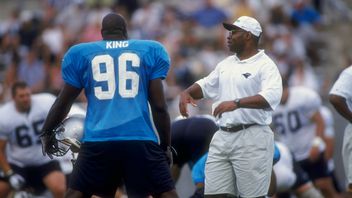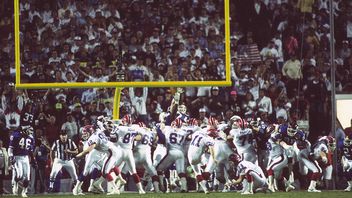Robert Weintraub | April 24, 2013
The original dual-threat
Before RGIII, there was Reggie Collier, college football's first great run-pass QB
Go ahead — click on the YouTube video. Check out that quarterback with the long strides and the dragster speed and the rocket-fueled passes. If not for the grainy production value and those crazy high white socks, you would swear you were watching Colin Kaepernick running wild. But that’s not the 49ers dual-threat wunderkind starring on your screen. Nor is it Robert Griffin III, Cam Newton, or Russell Wilson. It is the player who could have — should have — revolutionized the NFL three decades ago.
His name is Reggie Collier, and from 1979-1982 he starred at the University of Southern Mississippi. Alas, instead of being a pioneer at the quarterback position, he began a different trend, that of fantastic college dual-threat quarterbacks who never got the chance to turn the pro game on its ear.
Thirty years ago this week, the famous 1983 draft transformed the NFL in a different way. The insipid, trench-warfare style of play that most teams used in the 1970s was blown away by a new generation of quarterbacks who could tilt any field with their arms. Six of them were picked in that fabled first round; immortals John Elway of Stanford, Pitt’s Dan Marino, and Jim Kelly from Miami, along with three players who stumbled on the way to Canton, Tony Eason (Illinois), Todd Blackledge (Penn State), and Ken O’Brien (UC-Davis).
The sport shed its earthbound, hidebound approach, and took to the skies. As the rules increasingly began to favor the passing game, dropback quarterbacks with rifle arms became the league’s most-prized commodities. They were tall, with quick releases, occasionally shifty but seldom mobile (Elway being the notable exception). They were film room geeks always toting the playbook in one hand and a coffee in the other, because they showed up at the team facility at 6 a.m. They were charismatic and intelligent, with a flair for turning nothing into something.
And they were usually white.
But (usually black) dual-threat quarterbacks got left behind at the revolution. With rare exceptions, it would take another three decades before the NFL caught on to the advantages of their particular, unique skill set. Some gutsy coaches finally adapted pro offenses to match. Such imagination and courage was in short supply in 1983. That’s why the "1983 Six" wasn’t the "1983 Seven," and why the name Reggie Collier has been mostly lost to history.
. . . . .
Football fans in Hattiesburg, Miss., treasure Collier's junior season the way some towns recall a particularly bountiful harvest. The 1981 Golden Eagles had a season to remember, upsetting Mississippi State, destroying Florida State on national television, 58-14, and tying mighty Alabama, 13-13, at Legion Field in Birmingham, when Collier led his team down the field for a dramatic game-tying field goal. They finished 9-1-1 before losing a tight one to Missouri in the Tangerine Bowl.
He became the first Division I-A quarterback to top 1,000 yards rushing and passing in a single season.
Meanwhile, Collier was making history. He became the first Division I-A quarterback to top 1,000 yards rushing and passing in a single season. Think of that. In the entire storied history of college football to that time, no quarterback -- not one, ever -- had both rushed and passed for more than 1,000 yards in a single season. It wasn’t because of a lack of talented players, but a lack of freedom. Few coaches matched system to ability as USM’s Bobby Collins did with Collier. A player who turned up at Ohio State, like Cornelius Greene, who in 1973 became the Buckeyes first black starting quarterback, generally adapted to a three yards and a cloud of dust approach, regardless if his gifts lay elsewhere. As the years passed, the offenses spread out, and more schools used dual-threat quarterbacks. Combined 1,000-yard rushing, 1,000-yard passing seasons for college quarterbacks became more common, and soon enough there were also 1K/2K and even 1K/3K seasons. But no quarterback before Collier had cracked a grand on foot and through the air.
He put together another outstanding season as a senior in 1982, including a 38-29 win at Bryant-Denny Stadium, ending Alabama’s 57-game winning streak in the building. Southern Miss retired his No. 10 jersey, one of only three so honored in school history. You may have heard of the other two — the only punter ever drafted in the first round, Ray Guy of the Raiders, and Brett Favre.
John Cox, longtime radio voice of Southern Miss, put Collier’s game in perspective. "If he came along 10 years later he’d have been Michael Vick," he says.
But he didn't. And that led to a tough road for Reggie Collier, one that he isn’t eager to revisit, even 30 years later.
. . . . .
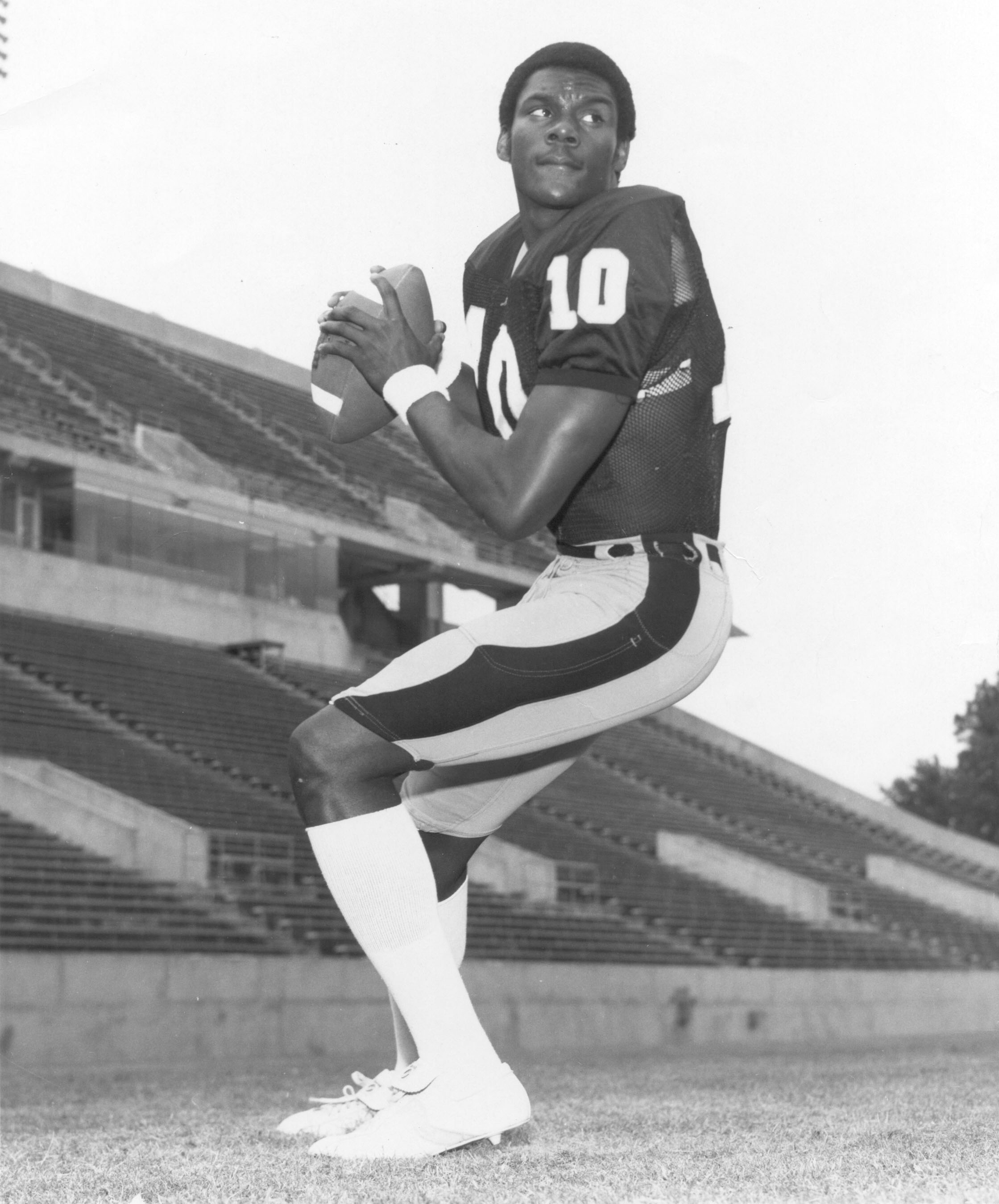
Today, no number of imaginary girlfriends on the Internet would be enough to cause a 6’4 QB with a big arm who ran a 4.5 40-yard dash, as Collier did, to fall out of the top five draft picks. But back in ’83, NFL teams still put skin color under "negatives" on their draft boards.
At that point, NFL teams had only sparingly allowed African-Americans to play quarterback. There was Marlin Briscoe, and James Harris, and Joe Gilliam, and Doug Williams, and ... that’s about it. None of these players were dual-threat guys, or were allowed to be, anyway. Sure, racism was a factor — blacks were presumed not to have the "faculties" to play the game’s most demanding position. And precious few owners were comfortable having a black man as the face of their franchise.
However, the prejudice combined with a failure of imagination — there simply wasn’t a professional coach who could or would conceive of the advantages garnered by having a quarterback who could run, and force defenses to prepare for an extra ball carrier. NFL teams saw Collier play, and somehow thought, in unison, "There’s a nice wide receiver prospect."
So the tall whirlwind with the cannon sat in Hattiesburg, waiting in vain for some team, any team, to work him out and fall in love. Alas, the team that showed the most interest played in Montreal. The Canadian Football League’s Concordes (the Alouettes’ replacement in the City of Saints from 1981-86) envisioned Collier working wonders with the extra length and breadth of Canadian fields.
"After Reggie’s last game (Montreal executives) were here and wanted to sign him right then," remembers Cox. "I thought if he went to Canada he would have been an absolute superstar with that wider field."
Instead, Collier had his head turned by the new girl in town, the one with long legs and deeper pockets. The United States Football League was just opening for business, and the franchise in Birmingham figured the kid who had bedeviled Bear Bryant would be their first star. With cash to burn in those heady early days, the new league money-whipped Collier, offering him a four-year, $2.5 million deal, with half a million bucks up front. Canada was instantly forgotten.
"This is the most exciting day of my life," Collier said at the news conference announcing his signing with the Stallions. "From the looks of it, I’m going to be very happy in Birmingham."
He wasn’t.
The USFL had a brief moment in the stratosphere before drifting too close to the sun and crashing back to earth. Superstars like Herschel Walker, Steve Young, and Anthony Carter gave the league cachet and entertainment value. However, there was no rich television contract or enough packed houses to recoup the type of money thrown at players like Collier. In 1985, after failing to gain legitimacy in an antitrust lawsuit against the NFL, the league came tumbling down. Collier was injured early in his career in Birmingham, and then bounced around to a couple of other teams, none of which tailored its offense to his gifts.
As for the money, what he managed to collect of that contract mainly went up his nose. The drugs started soon after he hobbled off the field, thanks to a combination of idle hands, bad company, and a hollow feeling in the pit of his stomach. The NFL, every football player’s dream destination, had been right there, yet frustratingly eluded his grasp. Collier spent many years trying to douse that pain with drugs and alcohol.
The Dallas Cowboys had taken a flyer on Collier back in the 1983 draft, figuring he would play wideout. The team still held his rights, and after the USFL went down in a heap, they brought Collier in to camp in 1986. At first, a miracle — the team told Reggie he would have his chance to play quarterback. But while then-coach Tom Landry may have been a defensive innovator, as Cox puts it, "Landry was too old school for a 6’4 black quarterback."
Growing up in D’Iberville, Miss., just across Back Bay from Biloxi, Collier’s grandparents, afraid he’d get hurt, refused to let him play football. He only became a regular starting quarterback as a senior in high school. So he was still somewhat unpolished, which didn’t enamor him to Dallas quarterbacks coach Paul Hackett.
"Hackett was really picky," Collier told the Pittsburgh Press in 1987. "I guess the way I did it didn’t really please him or Coach Landry. Coach Landry is not one who’s very big on improvising."
The vices did not help his cause. There’s an infamous story in Cowboy-land about Collier running a couple of series in practice before becoming so winded he begged Landry to call a halt so he could recover. His work habits were poor, his drive sapped by substances. Dallas let him go, and Collier drifted across the border into the hazy country of what might have been.
. . . . .
The greatest college football game it’s been my pleasure to witness in person took place in 1987, when I was an undergrad at Syracuse University. Don McPherson, the maestro of the freeze-option, central New York’s twist on the traditional scheme, led the Orangemen. He was unstoppable in ’87, leading Syracuse to an unbeaten record heading into the final game of the year against West Virginia.
Yes, he was black.
Running the show for the Mountaineers was a player even further advanced on the evolutionary stage from McPherson, a powerful and swift specimen about as easy to corral as a sea snake — Major Harris.
Yes, he too was black.
Harris was just a baby then, a freshman too talented to sit. He hadn’t yet pulled off his famous run against Penn State, when the team went left as he went right, leaving Harris to weave through the Nittany Lion defense unaided for a stunning touchdown. And he hadn’t yet led WVU to an unbeaten regular season of its own, which he would the following year in 1988.
But Major had run and passed West Virginia to a 31-24 lead late in the game, threatening to end Syracuse’s perfect season and national championship hopes. Then Donnie Mac had his final chance, marshaling the Orange down the field in the dying seconds, tossing a TD pass to make the score 31-30, and then pitching a perfect option toss to Michael Owens for the game-winning two point conversion.
I was delirious for weeks afterward, but never in my wildest fever dreams could I have foreseen that neither McPherson nor Harris would ever play a down in the NFL.
. . . . .
While blaming racism, myopia, and the stubbornness of the NFL establishment for the failure to embrace mobile quarterbacks for three decades is simple, it is not the full picture. Finding one’s way into a starting or even situational quarterback role in the NFL has always been about as likely as becoming an astronaut. And, as Tom Wolfe memorably put it in his book "The Right Stuff" about the climb to the top of the NASA pyramid, even for the most gifted players, the path to stardom can blow at any seam.
Blaming racism, myopia, and the stubbornness of the NFL establishment for the failure to embrace mobile quarterbacks for three decades is simple, it is not the full picture.
Many top dual-threat quarterbacks took changing positions not as an insult, but as a challenge. That’s why excellent players like Freddie Solomon (University of Tampa), Hines Ward (Georgia), Antwan Randle-El (Indiana), Josh Cribbs (Kent State) and Brad Smith (Missouri) wound up running routes and returning kicks with aplomb.
Brian Mitchell ran and passed for over 3,000 yards at Southwest Louisiana (now Louisiana-Lafayette) from 1986-89, but he never bothered knocking his head against the NFL’s ingrained bias against dual-threat quarterbacks. "It was a straight dropback league," he remembers. "It doesn’t bother me now, didn’t bother me then. When I came out my dream was just to play in the NFL, not play quarterback in the NFL. I was good enough of an athlete to make it at other positions, so I was fortunate." Mitchell is being humble — he put up more all-purpose yards than anyone in NFL history except Jerry Rice, mostly as a dominant returner.
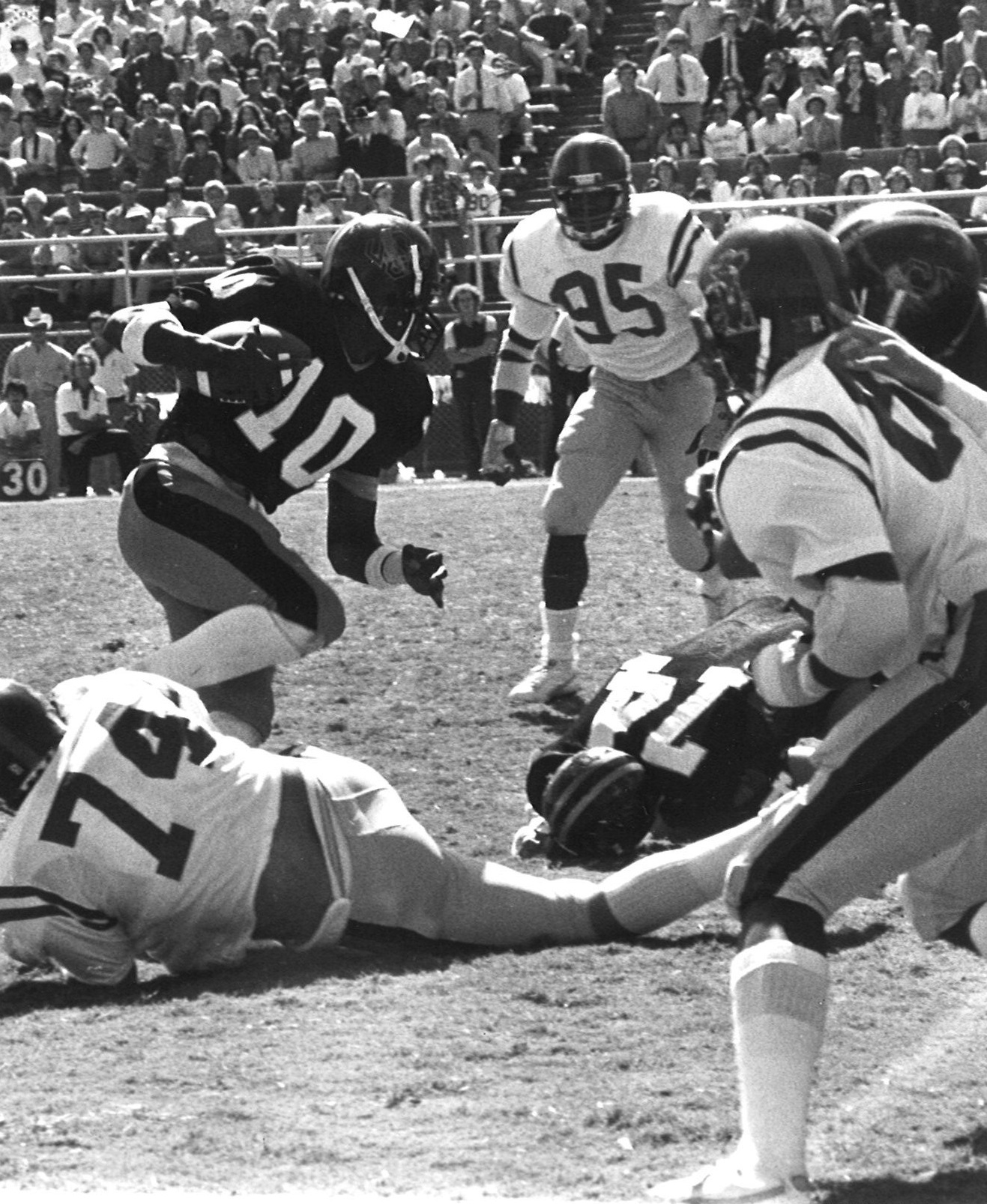
Of course, you can’t be a dual-threat player if the majority of your passes wind up over by the Gatorade bucket. That ruled out quarterbacks who just didn’t have the accuracy or arm strength to enable their pro coaches to tailor a system for them, guys like Jammal Lord (Nebraska), Woodrow Dantzler (Clemson), and Darian Hagan (Colorado). So, too, with Pat White. After being chosen in the second round of the draft in 2009 out of West Virginia, ostensibly to take part in a different NFL craze, the Wildcat, he might have set the cause back for a generation by flaming out. With teams opening up to the option, however, White is getting a second look this offseason, signing with the Redskins.
Beau Morgan of Air Force, like Mitchell, also put up over 3,000 yards both on the ground and through the air. As with his equally prolific service academy brethren Dee Dowis, Chance Harridge, and Ricky Dobbs, the combination of a military commitment after graduation and the punishing experience of running the triple option (as opposed to the read or spread version) made playing the position in the pros tough. "I was always beat up," Morgan recalls. "Some weeks I wouldn’t even practice, just trying to get healthy for the next game." One pro coach told Morgan he would need the two years of his commitment "to recover from getting the hell beat out of you."
The psychological demands dual-threat quarterbacking requires was another reason the NFL took a pass. "Option quarterback takes a toll not just physically, but mentally," Morgan notes. "It’s a real mental strain. You don’t get those 20-30 brainless handoffs per game to refresh your batteries. Every play is run through the quarterback and it’s a burden you don’t find in a pro-style offense."
That burden is one reason Morgan doesn’t think the option is here to stay, unlike Mitchell, who says, "I’ve been saying this for 15 years — we need more athletic types at quarterback or they’re gonna get killed. I think it’s here to stay. Colleges and high schools are running those offenses, and the NFL will adapt along with them. Everyone in the pros will come to realize that you need the quarterback to be the best athlete on your team, not just the best passer."
As it happened, despite the odds, Morgan came very close to hitting the lottery. On the day of the 1996 draft, he got a call from then-Cowboys coach Barry Switzer, who knew a little something about the option from his days dominating college football with the wishbone at Oklahoma. Morgan remembers Switzer telling him, "‘You picture yourself with a star on the side of your helmet and being on the cover of Sports Illustrated? We’re gonna run some goal-line option and we want you to do it.’"
Instead, Switzer was fired, Morgan switched to running back, and both moved on to non-football pursuits. So much for bucking the system.
For 30 years, with the rare exceptions like Vick and Randall Cunningham, dual-threat quarterbacks were shunted aside, before becoming overnight sensations last season. It’s hard not to think of baseball’s segregated era before 1947 when assessing this era of pro football. Were Elway and Marino really the best quarterbacks available in 1983? A few years earlier Joe Montana landed in an offense practically assembled to fit his particular strengths. What if fellow Notre Damer Tony Rice, winner of the Johnny Unitas Golden Arm Award and fourth in voting for the Heisman Trophy in 1989, had the same opportunity?
We’ll never know. Rice (who in fairness had a weak arm) went undrafted. Hopefully, future fans will be able to compare the likes of Kaepernick and Griffin with Aaron Rodgers and Andrew Luck, secure in the knowledge that non-traditional quarterbacks at last secured a place in the NFL.
. . . . .
Sometimes, the reason for failure was more subtle, like with the quarterbacks in that wondrous 1987 game in the Carrier Dome. Sports Illustrated projected Donnie McPherson as a first-round pick, but the league didn’t share the magazine’s ardor. It didn’t help that McPherson sent a letter to every team before the draft informing them that he was a quarterback, and not to bother picking him unless he received a chance under center.
McPherson was an odd duck, a guy who loathed the locker room ethos of, as he told SI in 1987, "Football, girls, drinking. Drinking, girls, football." A more conformist player might have carved out a chance at a career, but that wasn’t McPherson. "I’d rather be a fly on the wall," he said back in college, and that personality type doesn’t break barriers. He was a practice squadder in Philly and Houston for a couple of years, and was gone. At least he could take solace in the fact the Eagles ignored him in favor of the electrifying Cunningham, one of the rare dual-threats to break through back in the day.
Major Harris understood the game was rigged even as a collegian, when he told The New York Times, "I just think a black quarterback has got to be given an opportunity to show what he can do. There's a lot of stereotypes involved." When he decided to forego his senior season in Morgantown to enter the draft, Harris went rogue for his choice of agent, Ed Abrams, a San Francisco lawyer outside the stable of usual suspects. Abrams secured a large offer from the CFL, and told NFL teams that if Harris wasn’t selected in the top two rounds not to bother taking him at all. He wasn’t, and it was off to Vancouver, where the B.C. Lions picked him up from the airport in a Rolls-Royce.
Harris shrugged it off at the time. "I kind of knew I wouldn't get drafted," he told Scripps Howard News Service. "I had gotten to the point where I realized that it's more than just talent that goes into that [where players are drafted]. From a lot of people's standpoint, I might not have had the right agent — one of their [NFL owners] buddies."
It can blow at any seam.
Alas, Harris got hurt right away in Canada and returned to the States, where he bounced from the Arena League to a sad assortment of local yokel collectives, including the West Virginia Lightning of the National Minor Football League, the Southern Michigan Timberwolves of the Mid-Continental Football League, and the Washington Marauders of the Professional Spring Football League.
And another would-be Kaepernick slipped from view.
. . . . .
A decade later, Michael Bishop suffered a more common fate, one that befalls players at any position throughout the league — landing in the wrong place at the wrong time. In two years as a starter at Kansas State in the late-‘90s, Bishop ran or threw for 59 touchdowns, twice ran for over 100 yards and passed for 300 yards in a single game, and finished second to Ricky Williams in the 1999 Heisman balloting. Switching positions for the pros was anathema to him, even though, as he says today, "I heard the rumors about the league, that they didn’t like runners, they didn’t want anyone under 6’4"... But I thought I had the ability to make it." The New England Patriots took him in the seventh round, but their coach at the time — Pete Carroll! — buried Bishop on the bench.
(Brief aside — Bishop’s first cousin is the actor Jamie Foxx, a.k.a. "Steamin’" Willie Beamon from the movie "Any Given Sunday," perhaps football’s most successful mobile quarterback. I asked Michael about Foxx’s off-screen career as a high school QB, when he was known as Eric Bishop. "He was terrible!" Bishop laughs.)
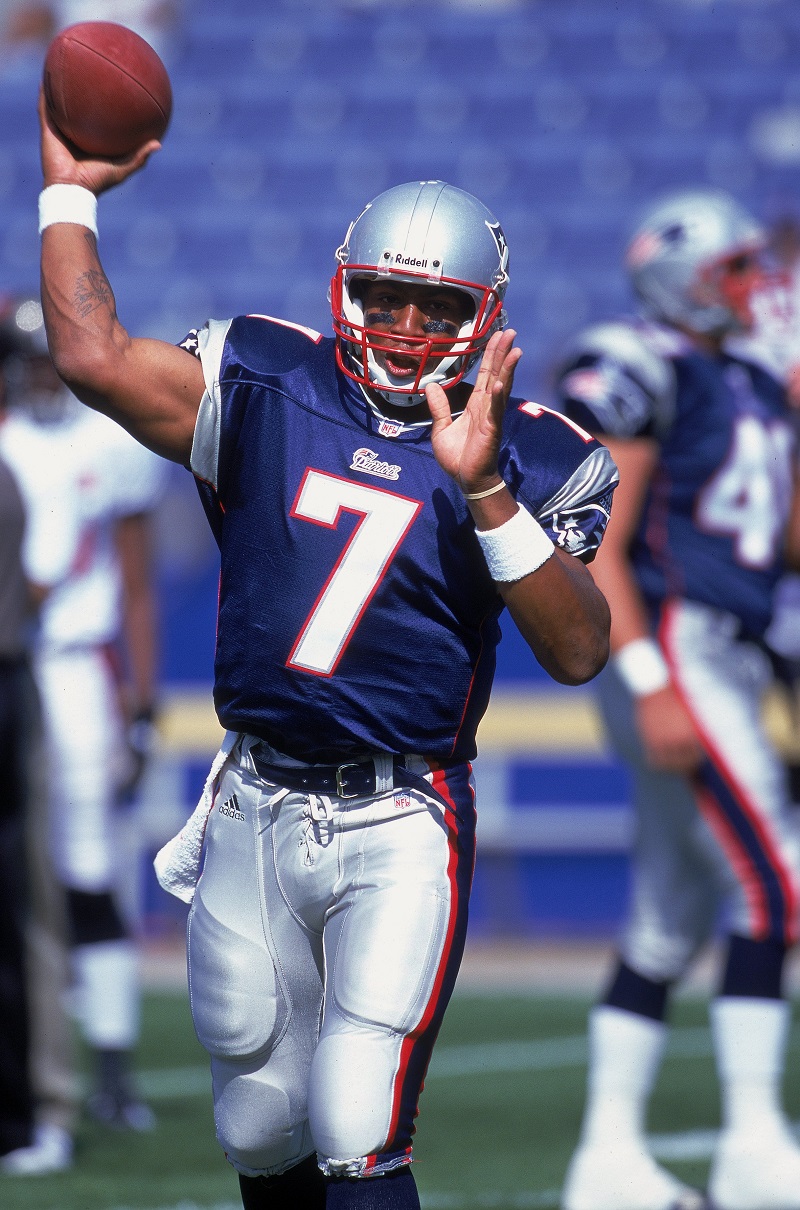
When Bill Belichick took over for Carroll in 2000, he had his creative offensive coordinator Charlie Weis develop a package for Bishop. However, the Patriots had just given Drew Bledsoe a record contract (10 years, $103 million), and he wasn’t about to come out of the game and watch Bishop run the option. Already the victim of one plank of NFL politics, that concerning running QBs, Bishop now was a victim of another, the law of the paycheck. "I remember sitting around and talking with (Tom) Brady about it. We were worried about never getting our chance."
His fellow backup would get that shot, but despite strong preseason showings and chants of "We want Bishop!" from the stands, Bishop never did. Let your mind drift over to a world where Bishop, not Tom Terrific, takes over as New England’s starter after Bledsoe got hurt in 2001. Would Bishop have three Super Bowl rings and a Brazilian supermodel wife? Would Belichick be teaching a typing class somewhere today?
Perhaps in that same alternate world, Chuck Yeager, the greatest pilot anyone ever saw, would have been the first man on the moon, not Neil Armstrong. But NASA only wanted college graduates for the space program.
On such light zephyrs do the winds of history change.
“I thought I had made my mark. But no one in the NFL wanted to take a chance.”
"To this day I have conversations with people in the league and they say, ‘You never got your opportunity, man, I would have loved to have seen you get your shot,’" Bishop says. "I came in on third down and did what I was supposed to do. I thought I had made my mark. But no one in the NFL wanted to take a chance." For Bishop, the CFL was a mixed blessing. For the better part of a decade, it provided him with a job. But there was a downside as well. "You’re only allowed four hours of practice time in Canada, so that meant I had a lot of time to sit and think while stuck in the middle of nowhere (Bishop played in Winnipeg, Calgary and Saskatchewan, for Pete’s sake). The CFL is full of guys who never got a real shot at the NFL, and we would sit around and feed off each other’s bitterness." The fact they weren’t making anything like NFL dollars didn’t help their attitudes either.
As I was talking with Bishop, about his hanging on in the Southern Indoor Football League (you know, the SIFL) with the Texas Hurricanes last year, it occurred to me that there is a natural path back to the NFL for Bishop and guys like him. If indeed dual-threat quarterbacks are the future, they logically will require coaches familiar with the style. "You can’t just take the guy who’s been coaching five-step drops all his life and have him coach up sprint out guys," Bishop agrees. "I think about coaching all the time. All the kids here in Texas run read option and pistol and sprint out sets — I’m talking peewee level. I’m out there coaching them every weekend. There’s no reason I can’t help out guys in the NFL, too."
Maybe he should give his first NFL coach a call. Pete Carroll owes Bishop one. "People say it to me all the time," he says. "Just the other day my cousin said it — ‘Imagine if Pete had given you the shot he gave Russell Wilson — how many doors would have opened up for any number of mobile quarterbacks?’"
. . . . .

The door never opened for Reggie Collier. He got high for years as a result. At long last, roughly at the stage he might have been wrapping up a successful, groundbreaking career in the NFL, he went to a rehab facility in Houston. It took nine weeks for him to get clean, but he made it out the other side.
Today, his addiction is behind him, but Reggie faces some stiff challenges. After several years of comfortable work at Southern Miss, ensconced in the bosom of his alma mater, he has taken a job with a recycling and waste management concern called Waste Pro. The company recently won a rich contract to take care of the trash in Forrest County, Miss., and Reggie is division manager, overseeing the new routes.
It hasn’t been easy. Many of his drivers don’t know the area, and two of them quit in frustration. Another lost his life in a car accident. Reggie himself has had to fill in and go out on pickups. Meanwhile the complaining phone calls to his office from unsatisfied customers pile up, adding to his already hectic days of trying to mount this new operation.
The upshot is that despite my efforts, I can’t get in touch with Reggie to talk about the old days. My thrice-daily phone calls trying to reach him are lost in the clutter. Give him this much — he’s not out there taking advantage of the NFL’s read-option revolution to sell his "woe is me" story. Keeping your eyes away from the rearview mirror is a key cog in besting addiction, and it’s understandable that Reggie isn’t eager to relive his drug-addled years.
Others have already told me he no longer carries any burden of regret over not being the man to change the NFL. "He’ll never say — ‘What a bad break’ — he never talks about it in those terms," says Cox. "He’s proud of his accomplishments after football. I know I would have been bitter about it." Nevertheless, my urge to meet and talk to the would-be Kaepernick or RGIII of the 1983 draft is palpable.
In a pique of desperation, I drive down to Mississippi from my home in Decatur, Ga. Six hours behind the wheel, beef jerky and Coke Zero by my side, from Atlanta’s urban sprawl through the rolling hills and smokestacks of the Alabama piedmont and into the misty lowlands of Hattiesburg. It’s another hour to Reggie’s old home on the Gulf Coast, but you can feel the sea’s presence in the thick air.
Early one March morning, I leave the Anywhere, USA vibe of central Hattiesburg (fast food chains and strip malls don’t merely dot the landscape, they are the landscape) and head west on Highway 98. Pretty soon long gaps divide man-made structures of any sort. In the hamlet of Oak Grove, Miss., I come upon the offices of Waste Pro, which sits just across the highway from Brett Favre’s spread (Reggie’s company collects Brett’s empties). As I drive past, I see Reggie’s Ford F-150 in the lot.
I’ve got him now ...
It takes about four minutes for me to drive to the next available U-turn on the highway, drive back past Waste Pro, reverse course again, and pull up to the lot. In that time, Reggie has managed to get in his truck and peel away. I see him turn the corner and head in the opposite direction on the highway, bound for Biloxi and the funeral of an old friend who died suddenly in the night. I watch him get smaller in my rearview mirror. I feel like a defender who fell for one of Reggie’s option fakes, my jock lying on the field as he storms down the field to pay dirt.
Damn — still elusive after all these years.
